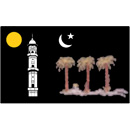Why is there division in Ahmadiyyat?
This is not really an objection, but someone may raise the question to you that why have Ahmadis split into two groups? And it is good to know the answer.
We have seen in every religion including Islam, that there are different groups formed. This has nothing to do with the Prophet, who is sent to unite the people, but sadly, after the Prophet’s death problems arise and differences start to take place amongst his followers.
The Holy Qur’an is very clear that we should not be divided into sects, Islam is about unity and oneness, Allah is One and there should be One community. But sadly, from very early on in Islam, within 30 years after the death of the Holy Prophet, may peace and blessings of Allah be upon him, during the time of Hazrat Uthman, may Allah be pleased with him, that changed and a sect was created. Soon after there became two major sects – Sunnis and Shias and now of course there are so many different sects in each major party.
Usually these sects are formed due to political reasons, a power struggle or a different interpretation to the teachings of the Prophet, and this is what also happened in Ahmadiyyat. Soon after the death of the Promised Messiah & Mahdi, a power struggle and differences developed and it resulted in a group branching away from Ahmadiyyat and they called themselves‘Ahmadiyya Anjuman Isha’at Islam or Lahori Ahmadis’.
When Hazrat Mirza Ghulam Ahmad, may peace be upon him, the Promised Messiah and Mahdi, sadly passed away, many of the leading members of the Community got together and agreed unanimously that Hazrat Maulvi Nurud-Din Sahib should be requested to undertake the heavy responsibility of leading the Community as the First Successor of the Promised Messiah and as Head of the Ahmadiyya Movement. This request was conveyed to Hazrat Maulvi Nurud-Din Sahib and after prayer he agreed to take on this heavy responsibility and became Hazrat Khalifatul Masih I.
Maulvi Muhammad Ali, a dedicated and respected companion of the Promised Messiah, and who was entrusted by the first Khalifa to do the English translation of the Holy Qur’an, was against the system of Khilafat and felt that the Sadr Anjuman Ahmadiyya should run the community. During the Khilafat of Hazrat Maulvi Nurud-Din Sahib, the dissenters could not freely give voice to their feelings, but upon his death, they started to openly oppose this system and wanted to defer indefinitely the election of the next Khalifa. But on the day after the first Khalifa had passed away, when his will was read out, to which he had suggested that the Community elect a new successor; everyone unanimously agreed to the proposed name of Mirza Bashiruddin Mahmud Ahmad. Quickly everyone present took the Bai’at at the hand of Mirza Bashiruddin and he became the second Khalifa of the Promised Messiah.
Maulvi Muhammad Ali and other dissenters left the congregation without performing the Bai’at. Within a few days they left Qadian and moved to Lahore where they founded their own organisation under the name of Ahmadiyya Anjuman Isha’at Islamor as they are more commonly known Lahori Ahmadis.
There are two main issues that they differ with us:
- The leadership of the Ahmadiyya Community should be by the Sadr Anjuman and not the Khalifa.
- The Lahori Ahmadis regard the Promised Messiah as only a reformer and not a Prophet.
As we have mentioned above, Maulvi Muhammad Ali desired, as Nazir Ala (head of Sadr Anjuman) to be in control of the community. He could not oppose Hazrat Maulvi Nurud-Din Sahib, the 1st Khalifa, but he felt that he could push his claim when Hazrat Maulvi Nurud-Din Sahib passed away. He failed in his bid to persuade the community to delay the elections, as he wanted to put forward his proposal that the Sadr Anjuman should lead the community. Therefore he decided to start his own community, where he would be able to control the community.
The position of the Sadr Anjuman Ahmadiyya at the time of the election was very clear:
After the demise of the Promised Messiah, the whole Jama‘at accepted Hazrat Maulana Nur-ud-Din as the Khalifah and took the pledge of allegiance. Khwaja Kamalud-Din, in his capacity as the Secretary of Sadr Anjuman Ahmadiyya, made the following announcement on behalf of all members of the Anjuman:
Before the funeral prayers of the Promised Messiah were offered, in accordance with Al-Wasiyyat of the Promised Messiah and in consultation with the leaders of the Sadr Anjuman Ahmadiyya, relatives of the Promised Messiah and with the permission of the Mother of the Faithful, the entire Jama‘at numbering about 1200, took a pledge at the hand of the most honoured, Pilgrim of the Holy Places, the respected Hakim Nur-ud-Din. The following respected personages were among those present at the occasion:Hazrat Maulana Sayyed Muhammad Ahsan, Sahibzadah Mirza Bashir-ud-Din Mahmud Ahmad, Nawab Muhammad ‘Ali, Sheikh Rahmatullah, Maulvi Muhammad ‘Ali, Dr. Mirza Ya‘qub Baig, Dr. Sayyed Muhammad Husain Shah, Khalifah Rashid-ud-Din, and the most humble Khwaja Kamal-ud-Din.
Continuing this statement Khwaja Sahib said:
All those present, whose number is mentioned above accepted him as Khalifatul Masih with unanimity. This letter is for the information of all members of the Jama‘at. On receiving this message, all members of the Jama‘at should personally or through letter, take a pledge of allegiance to Hazrat Hakimul-Ummat Khalifah of the Masih and Mahdi.
Al-Hakm, and Badr, June 2, 1908
The second issue again laid with Khwaja Kamalud-Din. He went to London for business and decided that he would have more success spreading the message of Hazrat Mirza Ghulam Ahmad, may peace be upon him, if he did not call him a Prophet. So for some time this was what he was doing in England, unknown to the Khalifa in India. When he returned in 1914 he started to propagate this idea to the Lahoris and delivered a lecture in Lahore where he was stating that the Promised Messiah was a Zilli or Baruzi Nabi and this meant that it was like an honorary title and not having the real status and privileges of Prophets (Al-Qaulul Fasl p.18).
Khwaja Sahib felt that through promoting the Promised Messiah like this, then they would be accepted as true Muslims and be able to have more success conveying the Promised Messiah’s teachings without being opposed and persecuted by Muslims.
Although the Promised Messiah did call himself as a Zilli or Baruzi Nabi, he made it clear that this meant that he was a reflection of the Holy Prophet and had attained his own Prophethood through the love and devotion he had towards our beloved Holy Prophet Muhammad, may peace and blessings of Allah be upon him. Therefore he made it clear that he was a Prophet.
http://www.alislam.org/library/books/A-Misconception-Removed.pdf
Furthermore, the leaders of the Lahori Group also had this belief and so the idea that he was only a reformer and not a Prophet was entirely against their own beliefs before they made the split. There are many incidences of this, but here is one each from the main two leaders:-
Maulvi Muhammad ‘Ali, during his speech in the Ahmadiyyah Building Lahore, said:
Whatever meanings the opponents may adopt, we are firmly established on the belief that God can raise Añbiya’ [prophets] . He can grant to people the status of the siddiq [truthful], the shahid [martyrs], and the saleh [righteous]. But there needs to be one who asks. The one at whose hand we pledged allegiance was true, he was a chosen and exalted Rasul, and the spirit of purification had reached its zenith in him.
As quoted in al-Hakam, July 18, 1908, p. 6
Al-Hakam dated May 14, 1911 reports:
The Batalvi, in his essay in Paisa Newspaper says that Khwaja Sahib has repudiated that the Promised Messiah is a Nabi or a Rasul. But the Batalvi will be mortified to learn that within his home Batala, Khwaja Sahib stated clearly in his lecture that, “In your neighbourhood has appeared a Nabi and Rasul. It is up to you to believe in him or not.
Speech of Khwaja Kamal-ud-Din Al-Hakam May 14, 1911
Therefore we can conclude that the forming of a new sect was political and sadly the Lahori Group despite their new views, were never accepted by the majority of Muslims and their group was also included in the infamous ordinance in Pakistan and they were also declared by law to be non-Muslims. Their numbers have dwindled and there is only a small number of the Lahori Jama’at living around the world.
For more information please look at the following link:
http://www.alislam.org/library/books/Truth-about-the-Split.pdf

















